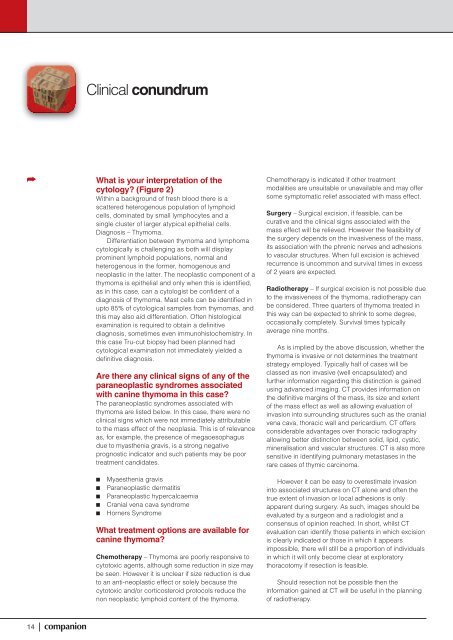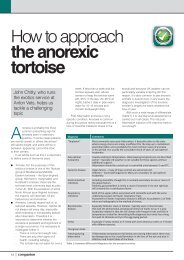Companion May 2012 - BSAVA
Companion May 2012 - BSAVA
Companion May 2012 - BSAVA
You also want an ePaper? Increase the reach of your titles
YUMPU automatically turns print PDFs into web optimized ePapers that Google loves.
14 | companion<br />
Clinical conundrum<br />
What is your interpretation of the<br />
cytology? (Figure 2)<br />
Within a background of fresh blood there is a<br />
scattered heterogenous population of lymphoid<br />
cells, dominated by small lymphocytes and a<br />
single cluster of larger atypical epithelial cells.<br />
Diagnosis – Thymoma.<br />
Differentiation between thymoma and lymphoma<br />
cytologically is challenging as both will display<br />
prominent lymphoid populations, normal and<br />
heterogenous in the former, homogenous and<br />
neoplastic in the latter. The neoplastic component of a<br />
thymoma is epithelial and only when this is identified,<br />
as in this case, can a cytologist be confident of a<br />
diagnosis of thymoma. Mast cells can be identified in<br />
upto 85% of cytological samples from thymomas, and<br />
this may also aid differentiation. Often histological<br />
examination is required to obtain a definitive<br />
diagnosis, sometimes even immunohistochemistry. In<br />
this case Tru-cut biopsy had been planned had<br />
cytological examination not immediately yielded a<br />
definitive diagnosis.<br />
Are there any clinical signs of any of the<br />
paraneoplastic syndromes associated<br />
with canine thymoma in this case?<br />
The paraneoplastic syndromes associated with<br />
thymoma are listed below. In this case, there were no<br />
clinical signs which were not immediately attributable<br />
to the mass effect of the neoplasia. This is of relevance<br />
as, for example, the presence of megaoesophagus<br />
due to myasthenia gravis, is a strong negative<br />
prognostic indicator and such patients may be poor<br />
treatment candidates.<br />
■■ Myaesthenia gravis<br />
■■ Paraneoplastic dermatitis<br />
■■ Paraneoplastic hypercalcaemia<br />
■■ Cranial vena cava syndrome<br />
■■ Horners Syndrome<br />
What treatment options are available for<br />
canine thymoma?<br />
Chemotherapy – Thymoma are poorly responsive to<br />
cytotoxic agents, although some reduction in size may<br />
be seen. However it is unclear if size reduction is due<br />
to an anti-neoplastic effect or solely because the<br />
cytotoxic and/or corticosteroid protocols reduce the<br />
non neoplastic lymphoid content of the thymoma.<br />
Chemotherapy is indicated if other treatment<br />
modalities are unsuitable or unavailable and may offer<br />
some symptomatic relief associated with mass effect.<br />
Surgery – Surgical excision, if feasible, can be<br />
curative and the clinical signs associated with the<br />
mass effect will be relieved. However the feasibility of<br />
the surgery depends on the invasiveness of the mass,<br />
its association with the phrenic nerves and adhesions<br />
to vascular structures. When full excision is achieved<br />
recurrence is uncommon and survival times in excess<br />
of 2 years are expected.<br />
Radiotherapy – If surgical excision is not possible due<br />
to the invasiveness of the thymoma, radiotherapy can<br />
be considered. Three quarters of thymoma treated in<br />
this way can be expected to shrink to some degree,<br />
occasionally completely. Survival times typically<br />
average nine months.<br />
As is implied by the above discussion, whether the<br />
thymoma is invasive or not determines the treatment<br />
strategy employed. Typically half of cases will be<br />
classed as non invasive (well encapsulated) and<br />
further information regarding this distinction is gained<br />
using advanced imaging. CT provides information on<br />
the definitive margins of the mass, its size and extent<br />
of the mass effect as well as allowing evaluation of<br />
invasion into surrounding structures such as the cranial<br />
vena cava, thoracic wall and pericardium. CT offers<br />
considerable advantages over thoracic radiography<br />
allowing better distinction between solid, lipid, cystic,<br />
mineralisation and vascular structures. CT is also more<br />
sensitive in identifying pulmonary metastases in the<br />
rare cases of thymic carcinoma.<br />
However it can be easy to overestimate invasion<br />
into associated structures on CT alone and often the<br />
true extent of invasion or local adhesions is only<br />
apparent during surgery. As such, images should be<br />
evaluated by a surgeon and a radiologist and a<br />
consensus of opinion reached. In short, whilst CT<br />
evaluation can identify those patients in which excision<br />
is clearly indicated or those in which it appears<br />
impossible, there will still be a proportion of individuals<br />
in which it will only become clear at exploratory<br />
thoracotomy if resection is feasible.<br />
Should resection not be possible then the<br />
information gained at CT will be useful in the planning<br />
of radiotherapy.



